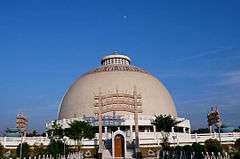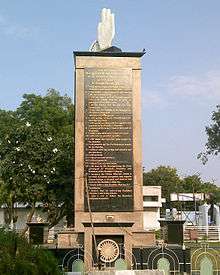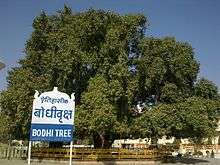Deekshabhoomi
| Deekshabhoomi | |
|---|---|
| दिक्षाभूमी | |
 Deekshabhoomi | |
| General information | |
| Type | Religious and historical monument |
| Architectural style | Stupa |
| Location | Nagpur, Maharashtra, India |
| Address | Central Nagpur[1] |
| Coordinates | 21°7′41″N 79°4′1″E / 21.12806°N 79.06694°E |
| Construction started | July 1978 |
| Inaugurated | 18 December 2001 |
| Design and construction | |
| Architect | Sheo Dan Mal |

Deekshabhoomi is a sacred monument of Buddhism at the place where the architect of the Indian Constitution, Dr. Babasaheb Ambedkar,[2] went back to Buddhism with his about 600,000 followers on 14 October 1956.[3][4] Ambedkar's return to Buddhism is an important matter for many in India.[5]
Deekshabhoomi is in Nagpur, Maharashtra, a location regarded as a pilgrimage center of Buddhism in India. Millions of pilgrims visit Deekshabhoomi every year,[6] especially on 'Dhamma Chakra Pravartan Din' (Mass Conversion Ceremony Day)[7] and 14 October, the memorial day when Dr. Ambedkar converted to Buddhism here. Ambedkar's final religious act was to embrace Buddhism.[6] Now, the biggest stupa in Asia is erected in his memory at the place.[8]
Deeksha literally means 'act of ordaining'[9] and bhoomi means the 'ground'.[10] Deekshabhoomi means the ground where people got ordained as Buddhist. This religious mass conversion at one place was the first ever of its kind in history.[2] Deekshabhoomi is one of the two places of great importance in the life of Dr. Ambedkar, the other being Chaitya Bhoomi at Mumbai.[11]
History
Ambedkar had declared in 1935 that although he was born as a Hindu he would not die as one,[12] as conversion was the solution to abandon the caste system.[13] After this declaration, he extensively studied the doctrines of all the major religions to choose Buddhism for himself and his followers.[13]
Buddhism was 2,550 years old in 1956, so it was notable year for global celebration and 14 October was the traditional date of conversion of greatest Buddhist King, Ashoka Maurya, the celebration of Ashok Vijaya Dashmi.[14] He selected Nagpur for his conversion ceremony, as he explained in his speech at that occasion, because Nagpur was the homeland of 'Nag' people who embraced Buddhism, supported it with great efforts in its early period, and propagated it throughout India.[15][16] Ground near the Ramdaspeth area in Nagpur was selected for the ceremony.
On 14 October 1956, Ambedkar and his wife took the oath of Three Jewels and Five Precepts from the Burmese monk Mahasthavir Chandramani from Kushinagar.[17][18] Ambedkar then gave the oath of Three Jewels, Five Precepts, and 22 Vows to his thousands of followers.[17] In this way, Nagpur became the birthplace of Neo Buddhist movement.[19]
Ambedkar died on 6 December 1956, one and a half months after the Deeksha ceremony. However, this ceremonial conversion continued after his death, converting 15-20 million by March 1959.[20] After his death the 'Dr. Ambedkar Smarak Samiti' (Dr. Ambedkar Memorial committee) was organized for the management of Deekshabhoomi. The committee decided to build a stupa at the place as a monument of that ceremony and a mass conversion of people to Buddhism.
Architecture
Construction
Deekshabhoomi is spread over four acres of significant land in the city.[2] The stupa was designed by architect Sheo Dan Mal.[21] In 1968, construction started with residential houses for monks, later on P/G College. Construction of the stupa started in July 1978, but it took a long time to finish.[22] The stupa was inaugurated on 18 December 2001 by the President of India K. R. Narayanan.[8]
Stupa
It comprises a large two storied hemispherical buildings with gates resembling a Sanchi gate.[2] Five thousand monks can stay in each storey.[22] The design of the stupa at Deekshabhoomi is based on the architecture of the world famous stupa of Sanchi.[23] But unlike the stupa of Sanchi, Deekshabhoomi stupa is completely hollow inside.[19][24][25][26] It is the largest hollow stupa among all Buddhist stupas in the world.[19] The inner circular hall is spread across 4000 square feet[2] with granite, marble and Dholpur sandstone used in its construction.[22]
On the ground floor, there is a 211 x 211 feet large square hall. At the center of this hall, an image of Buddha is placed. This image was donated to Deekshabhoomi by Thai students studying at Nagpur University. There is a library and a photo exhibition of the events in the lives of Gautama Buddha and Dr. Ambedkar.
Above the hall, there is a hollow dome. This dome is surrounded by a veranda. On all four sides, fountains are placed. Above the dome, there is a small slab and a little decorative umbrella. The stupa has doors facing four directions. The doors open in large arcs, which are decorated with Ashok Chakras, and statues of horses, elephants, and lions.
Around the stupa, there is a garden that is maintained by the Nagpur Improvement Trust.[27] Statues of Dr. Ambedkar and images of Gautama Buddha are in front of the stupa.
Vihar and the Bodhi Tree

In front of the stupa, on the right hand side, there is a Buddha Vihara with a bronze image of lord Buddha.
Besides the Vihara, there is the Bodhi Tree: a sacred fig tree. This Bodhi Tree was planted at Deekshabhoomi from three branches of the Bodhi Tree at Anuradhapura in Sri Lanka. Bhadant Anand Kausalyayan brought these branches from Sri Lanka as a memorial of Buddha's enlightenment.[28]
Tourism
Deekshabhoomi is famous for its architectural beauty and historical importance. It is one of the main centers of tourism in India.[6] Every year, thousands of tourists visit Deekshabhoomi, especially on the anniversary of the conversion ceremony.[29] On Dhamma Chakra Pravartan Din, thousands of compact cassettesTemplate:Update? of Ambedkar, Ambedkar movement and Buddha songs are sold at Deekshabhoomi. The books of few crore rupees in different languages are sold in a single day, this makes Deekshabhoomi a unique place in the world.[30]
Foreign tourists come mainly from the Buddhist countries such as Japan and Thailand.
See also
References
- ↑ Keer, Dhananjay. Dr. Ambedkar: Life and Mission (in Marathi).
- 1 2 3 4 5 Philip, A. J. (13 November 2005). "Warriors of the faith". The Tribune. Retrieved 30 June 2013.
- ↑ This was Ambedkar's own figure given by him in a letter to Devapriya Valishinha dated 30 October 1956. The Maha Bodhi Vol. 65, p.226, quoted in Dr. Ambedkar and Buddhism by Sangharakshita.
- ↑ Gautam, C (May 2000). "Life of Babasaheb Ambedkar". Milan House, 8 Kingsland Road, London E2 8DA: Ambedkar Memorial Trust. Retrieved 1 July 2013.
- ↑ Ramesh, Randeep (14 October 2006). "Untouchables embrace Buddha to escape oppression". The Guardian. Hyderabad. Retrieved 1 July 2013.
- 1 2 3 "Places to Visit". District Collector Office, Nagpur Official Website. Retrieved 30 June 2013.
- ↑ Lelyveld, Joseph. Great soul Mahatma Gandhi and his struggle with India (1st ed.). New York: Alfred A. Knopf. p. 210. ISBN 0307595366.
- 1 2 Bhagwat, Ramu (19 December 2001). "Ambedkar memorial set up at Deekshabhoomi". Times of India. Retrieved 1 July 2013.
- ↑ "दीक्षा or dīkṣā". SHABDKOSH™ English Hindi Dictionary. Retrieved 30 June 2013.
- ↑ The Pali Text Societies Pali-English Dictionary, Digital Dictionaries of South Asia. "Bhummi". University of Chicago. Retrieved 30 June 2013.
- ↑ Rao, Anupama (2009). The caste question: Dalits and the politics of modern India. Berkeley, CA: University of California Press. p. 184. ISBN 0520257618.
- ↑ Frances, Pritchett W. "DR. AMBEDKAR'S LIFE-- and beyond". Columbia University New York, NY : Department of Middle Eastern, South Asian, and African Studies. Retrieved 30 June 2013.
- 1 2 Jaffrelot, Christophe (2001). "The 'solution' of conversion". Dr Ambedkar and untouchability : analysing and fighting caste (Rev. ed.). London: C. Hurst. pp. 119–142. ISBN 1850654492. Retrieved 30 June 2013.
- ↑ Queen, Christopher S (1996). "Introduction: The shape and sources of Engaged Buddhism". Engaged Buddhism: Buddhist Liberation Movements in Asia. SUNY Press. p. 12. ISBN 1438416644.
- ↑ Frances, Pritchett W. "Why Was Nagpur Chosen?". Department of Middle Eastern, South Asian, and African Studies: Columbia University New York, NY. Retrieved 1 July 2013.
- ↑ Naik, edited by Y. Sudershan Rao, G. Bhadru (2008). "Buddhism: The way to world peace in Modern Society". Buddhism and modern society. New Delhi: Deep & Deep Publications. p. 57. ISBN 8184500599.
- 1 2 Sangharakshita (2006). "The Great Mass Conversion". Ambedkar and Buddhism (1st South Asian ed.). New Delhi: Motilal Banarsidass Publishers. pp. 127–138. ISBN 8120830237. Retrieved 30 June 2013.
- ↑ Bellwinkel-Schempp, Maren; Beltz, Johannes (2004). "Roots of Ambedkar Buddhism in Kanpur". In BELTZ, JOHANNES; JONDHALE, SURENDRA. Reconstructing the world : B. R. Ambedkar and Buddhism in India (PDF). New Delhi [u.a.]: Oxford Univ. Press. pp. 221–244. ISBN 0195665295. Retrieved 30 June 2013.
- 1 2 3 Malik, Ashok (17 March 2002). "Celebrating a unique city". The Tribune. India. The Tribune Trust. Retrieved 1 July 2013.
- ↑ Sangharakshita (2006). "After Ambedkar". Ambedkar and Buddhism (1st South Asian ed.). New Delhi: Motilal Banarsidass Publishers. pp. 162–164. ISBN 8120830237.
- ↑ "Dr Ambedkar memorial architect Sheo Dan Mal passes away" (Web). OneIndia. 25 January 2007. Retrieved 5 January 2009.
- 1 2 3 "CEE MH E-Z NAGPUR". Bharat Sanchar Nigam Ltd. Retrieved 1 July 2013.
- ↑ Seneviratne, Kalinga (16 January 2009). "Hope for India's 'broken' Buddhists". Asia Times. Asia Times Online (Holdings), Ltd. Retrieved 2 July 2013.
- ↑ Lochtefeld, James G. "Sanchi Stupa--A World Heritage Site". Religion Dept., Carthage College, 2001 Alford Drive, Kenosha, WI 53140: Religion, Carthage College. Retrieved 1 July 2013.
- ↑ Behl, Benoy K. (8–21 September 2007). "Harmony set in stone". THE HINDU; Frontline. 24 (18). Retrieved 1 July 2013.
- ↑ "World Heritage Sites - Sanchi". Archaeological Survey of India, Government of India. Retrieved 2 July 2013.
- ↑ "Gardens". Nagpur: Nagpur Improvement Trust. Retrieved 1 July 2013.
Deeksha Bhoomi
- ↑ Lella Karunyakara, Modernisation of Buddhism: Contribution of Ambedkar and Dalai Lama XIV, page 175, ISBN 81-212-0813-0
- ↑ "Thousands visit Deekshabhoomi in Nagpur" (Web). The Hindu. 7 December 2006. Retrieved 5 July 2008.
- ↑ "बुद्धाकडे जनता वळे, भीमा तुझ्या जन्मामुळे...". Sakal (in Marathi). Nagpur. The Sakal Group. 26 October 2012. Retrieved 7 August 2013.
आंबेडकरी चळवळीच्या, बुद्ध आणि भीमगीतांच्या हजारो कॅसेट्स एका दिवशी खरेदी होतात. पुस्तकांच्या तीनशेपेक्षा जास्त स्टॉल्सवर खरेदीसाठी झुंबड उडते. मराठीसह हिंदी, इंग्रजी भाषांतील पुस्तकांची दरवर्षीची विक्री सर्वांनाच ठाऊक आहे. परंतु, यावर्षी दक्षिणेतील तमीळ, कानडी भाषांतील पुस्तकांचे स्टॉल लावण्यात आले. याशिवाय श्रीलंकेतील सिंहली भाषेतील बुद्धाचे साहित्य यावर्षी खरेदीसाठी होते. कोट्यवधीची पुस्तकखरेदी एका दिवशी होणारे दीक्षाभूमी हे जगातील एकमेव ठिकाण आहे, हे विशेष.
| Wikimedia Commons has media related to Deekshabhoomi. |
Literature
- Special issue of Lokrajya, the publication of Govt. of Maharashtra on silver jubilee of 1956 ceremony.
- Deeksha, Special issue of Daily Sakaal in October 2005
- "दीक्षाभूमी'चा भूखंड आवळेबाबूंच्या संघर्षाचे फलित